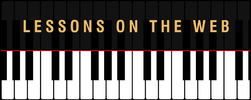|
Major scales are something that we start learning and playing on the piano pretty early on and we usually start with the C Major scale. If you’ve ever listened to music that sounded a bit more sad and melancholy than a fast past upbeat type of piece, then it might be in a minor key. That’s actually one of the ways we can identify a minor key is that is usually sounds somber. Minor keys are a bit more involved than Major Keys as there are three different types of minor scale for each key. They are:
Every major key has a relative minor and that minor is 3 half steps down from the major key. In other words, to find the relative minor of C Major, simply count down 3 half steps from C, which is A; so the relative minor of C Major is A Minor. The A Minor scale can be played in the Natural, Harmonic, or Melodic form, just like all other minor scales. Any relative minor scale will share the same key signature with the relative major. A minor has the same key signature that C major does. To play an A Minor scale you simply start on A and play up to the following A, making sure that every note is the same as it is in C. This type of minor scale is called the Natural Minor and will it always have the same key signature as the relative Major. Harmonic Minor scales are not the same as the relative major. In the Harmonic Minor scale, the next to the last note, or the 7th tone of the scale is raised a half step. This will be true any time you play a Harmonic Minor Scale…you will play it just like the Natural Minor except you will raise the 7th tone a half step…going up and coming back down; both ways are the same.
Melodic Minor scales have the most changes of all three of these different forms. We only had one change in Harmonic Scales and that change stayed the same going up and coming back down the scale. Melodic Minor Scales change not one, but two notes which are the 6th and the 7th tones of the scale. Further, these changes are not repeated coming back down but instead you return to the Natural Minor form for the descending part of the scale. Both the Harmonic and Melodic Minor scales sound similar, the Melodic Minor scale sounds the closest to a major scale going up the octave, and then remember that it will sound like and be just like the Natural Minor form coming back down. Once you understand the unique elements about each form of minor scale and how to recognize it when you hear it, playing your minor scales will be fun and you’ll enjoy the variety of ways that you can play them. This video shows you examples of each of these three types of minor scales in different keys so you can see how easy it is to figure them out on your own keyboard. It will also go over how to find the relative major or minor of any key on your piano keyboard and what these changes in your notes look like in sheet music. If you like my tips and lessons, you will love the courses over on my website. Whether you are a beginner looking to get a solid foundation to build on or you are looking to take you existing skills to that next level, the online music courses on my website https://www.pianolessonsontheweb.com will help you do just that.
Helder
2/14/2022 11:39:27 am
Hi I'd like to know how is a melody connected to a harmonic scale? Are the notes within a harmonic scale set to some of the notation within a melodic scale?
Reply
Leave a Reply. |
AuthorMost blogs written by Archives
June 2020
Categories
All
|

 RSS Feed
RSS Feed